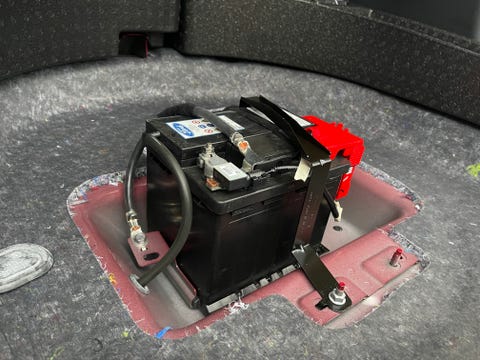Year by year, lithium-ion battery technology improves, and EV range and performance leap forward. We're now seeing electric pickups trucks with what would've been supercar acceleration not too long ago, a sedan with 520 miles of range, and Hyundais and Kias that use 800-volt charging. And yet, most of the electric cars and PHEVs on the road right now, whatever their range or 0-to-60-mph time, depend on a relic to get moving: a 12-volt battery, usually of the lead-acid variety. Your Tesla Model 3 Performance might have dual motors and the ability to drift, but its lithium traction battery is worthless without the help of a battery you might see lining the shelves at your local O'Reilly's. And if you kill it, you'll be bricked, regardless of how much charge is left in the high-voltage battery. In that photo above, the Bronco is jump-starting the Leaf, not the other way around. Water, water everywhere, but not a drop to drink. Why is that?
There are a couple of reasons. First of all, an electric vehicle has two distinct needs when it comes to dispatching electrons: moving the car and everything else. Propulsion is handled by the big, expensive, latest-and-greatest high-voltage battery, because you need lightning in a bottle if you want to do the quarter-mile in 9.4 seconds. For charging, the more voltage, the better. But powering up the stereo does not require 800 volts. Nor would you want that coursing through every circuit in the car, for a variety of reasons. Safety, for one.
We asked Hyundai's EV engineers why the 12-volt battery persists, and Ryan Miller, manager of electrified powertrain development, responded. "All the ECUs in the vehicle are powered from the low voltage, as well as the power relays that separate power from the high-voltage battery pack and the rest of the high-voltage network in the car," he said. "That separation allows us to safely disconnect the high voltage from the low voltage when the vehicle is not being driven or in the event of a crash." You don't want first responders to contend with door locks powered by Doc Brown's Mr. Fusion.
There's also a legacy situation at play. Everyone—manufacturers and suppliers—knows how to make a 12-volt system work, affordably and reliably. Even if you manage to drain the 12-volt battery, you can break out the ol' jumper cables or Weego and solve the problem in a minute or two. Given all the other financial and technical challenges of building an EV, going with a 12-volt system for the car's computers and accessories makes sense. That's particularly true in the case of plug-in hybrids, which often retain as much commonality as possible with their traditional internal-combustion cousins. The plug-in Ford Escape Hybrid uses a 14.4-kWh battery pack good for 37 miles of EPA-rated range, but the whole thing powers up via an old-school lead-acid 12-volt bolted in the spare-tire well under the rear cargo floor.
It remains to be seen whether the world adopts some other common voltage—24 volts, or 48—but for now, the 12-volt system reigns. Whether that will always mean a separate battery that would work equally well in a 1968 Chevelle is more of an open question. Hyundai, for instance, considered the absurdity of jump-starting an electric car or hybrid and connected its low-voltage systems to the large traction battery, allowing electrified Hyundais to jump-start themselves when you push the "12V Batt Reset" button on the dash. And while that button conjures an image of your standard AC Delco lead-acid, the low-voltage systems are actually run by a 14-volt lithium-ion battery that sits inside the high-voltage battery pack. You won't find that at the local auto-parts store.
So it's entirely possible that the 12-volt system lives on. But the 12-volt battery itself? That's another question.
This content is created and maintained by a third party, and imported onto this page to help users provide their email addresses. You may be able to find more information about this and similar content at piano.io
"electric" - Google News
January 02, 2022 at 10:00PM
https://ift.tt/3eKmodG
Why Do Electric Cars Still Use 12-Volt Batteries? - Car and Driver
"electric" - Google News
https://ift.tt/2yk35WT
https://ift.tt/2YsSbsy
Bagikan Berita Ini

















0 Response to "Why Do Electric Cars Still Use 12-Volt Batteries? - Car and Driver"
Post a Comment